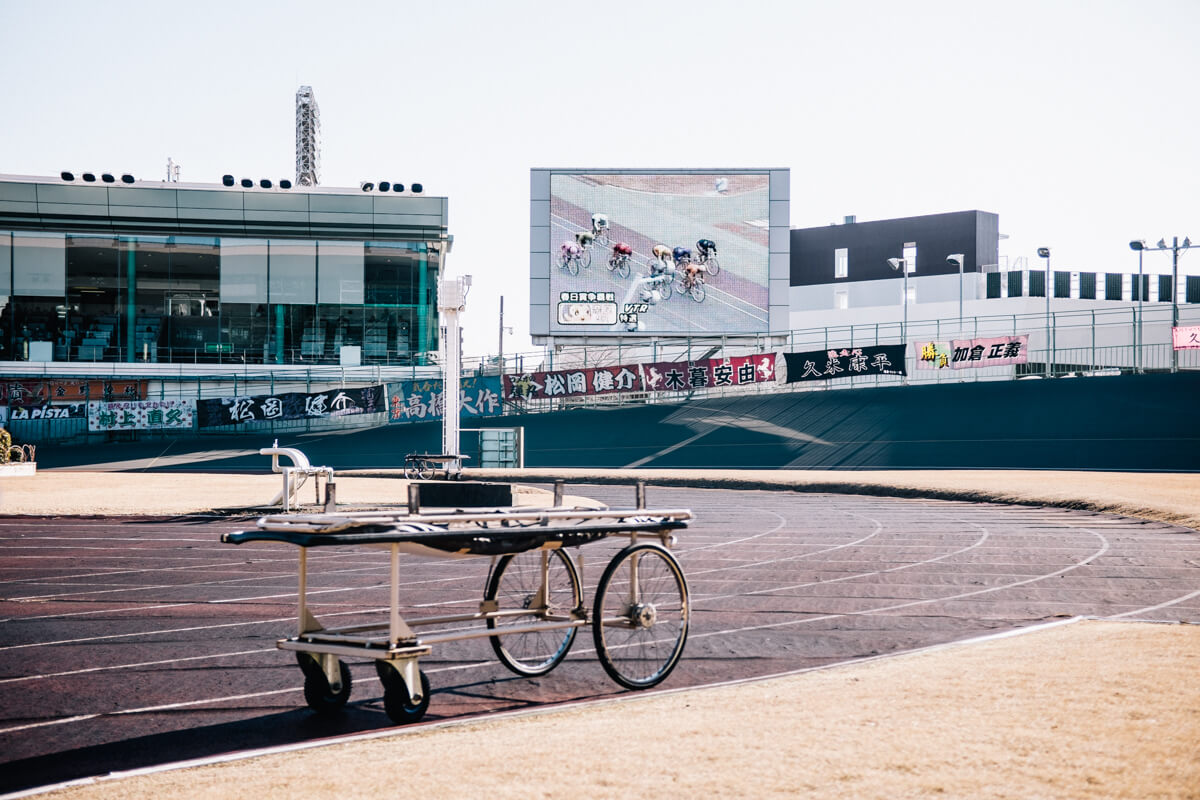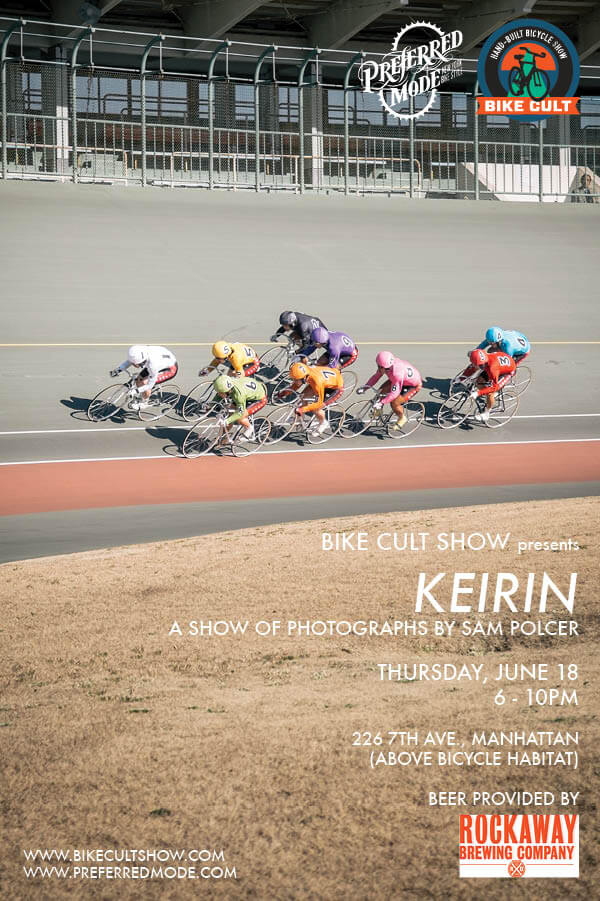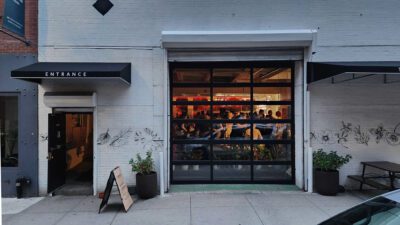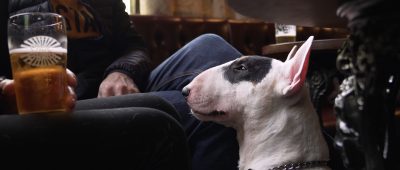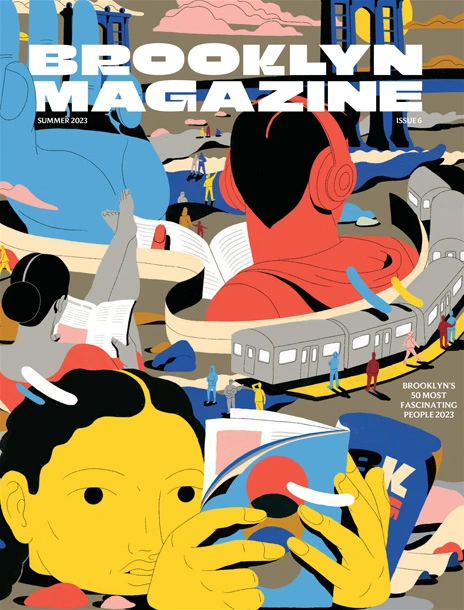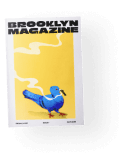A Behind the Scenes Look at Japan’s Insane Bike Races
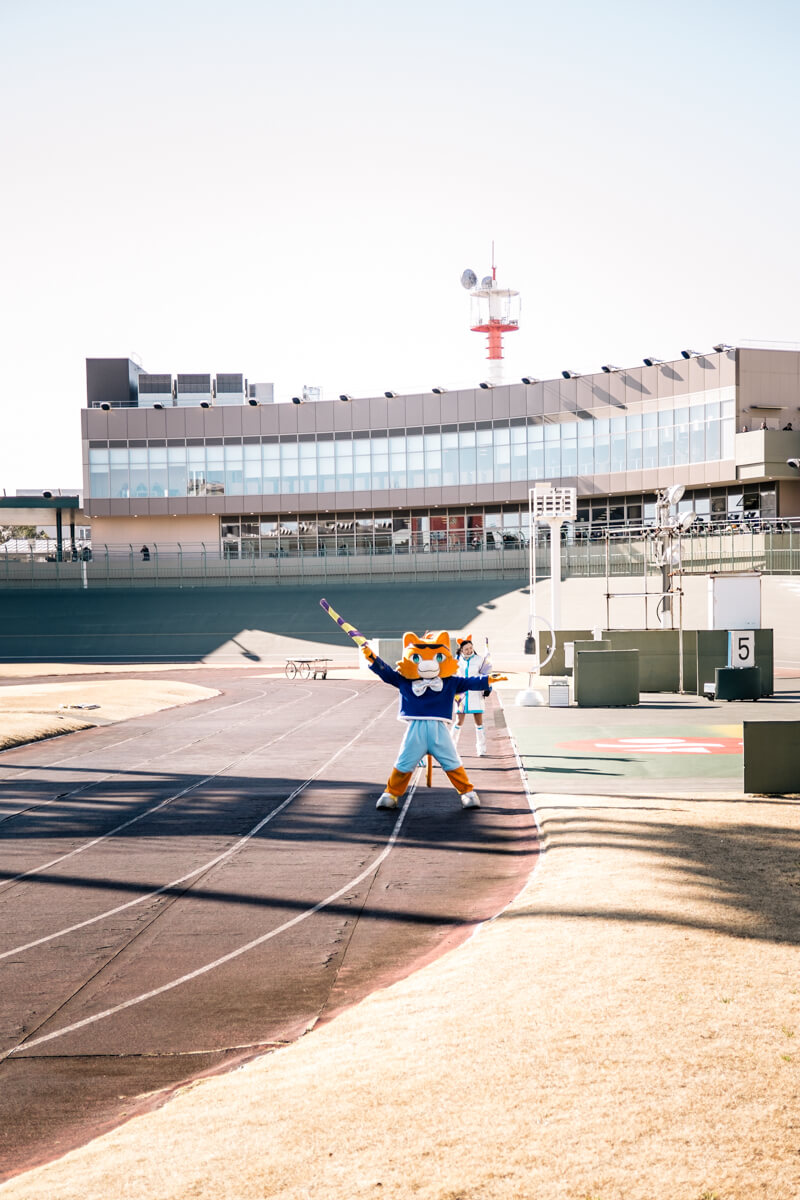

Mascots announce the arrival of the racers with a dance routine
While traveling throughout Asia this past winter, Brooklyn-based photographer Sam Polcer spent a day behind the scenes of a Keirin race in Kawasaki, a city near Tokyo. Since originating in 1948, Keirin, which translates to “racing wheels,” has exploded in popularity as a high-intensity gambling sport with a surrounding culture of rabid fandom. Aspiring cyclists first have to get into highly selective Keirin schools, where they train for 15 hours a day.
Polcer is best known for his photographs of the chic bicyclists of New York City: He’s documented the likes of David Byrne on his Jammis Commuter, Brooklyn’s Puerto Rico Schwinn Club, in leather patch vests, BMX kids at skate parks, and Williamsburg’s flowy-skirted fixed-gear fashionistas, both on his blog and in his book. But for this most recent photo series, he turned his camera on Japan’s fiercest bike race, in which six to nine riders zoom around a track at up to 43 miles per hour, competing for large purses.
Polcer’s photos of the event, on view this Thursday in a one-day exhibit at Bike Cult Show in Chelsea, capture the adrenaline-fueled intensity and visual elegance of Keirin: they feature cyclists in neon spandex; stretchers positioned around the track; dancing mascots; and crowds of gamblers.“I remember being really surprised when they told me that all the racers have to stay onsite at the velodrome for three days leading up to the event, to keep things as fair as possible for the gamblers,” Polcer says. “That kind of opened my eyes to how seriously they take it. It’s a big industry.”
The images complement Polcer’s previous photos of cyclists in the way they celebrate the bicycle as both a practical vehicle, part of a lifestyle, and an object of sculptural beauty. We caught up with Polcer about his bike obsession and his time shooting Kawasaki’s Keirin races.
Who is the average Keirin track racer in Japan? What is the racing culture like?
Apparently it’s hard to become a Keirin racer. You have to go to school for it, and only 10% of applicants are accepted to the school, where you train for like 15 hours a day. At the velodrome, everyone’s all kitted out and practicing on rollers and checking the components on their bikes, which are impeccably maintained. As for who actually decides to become a Keirin racer, I don’t know—I guess it’s anyone who gets into the program. I saw a wide age range. And they didn’t used to have female Keirin racers, but now they do—although it was pointed out to me that the slogan on a poster promoting “The Girls of Keirin” could be translated as something like, “it’s not about faces, it’s about big thighs.”
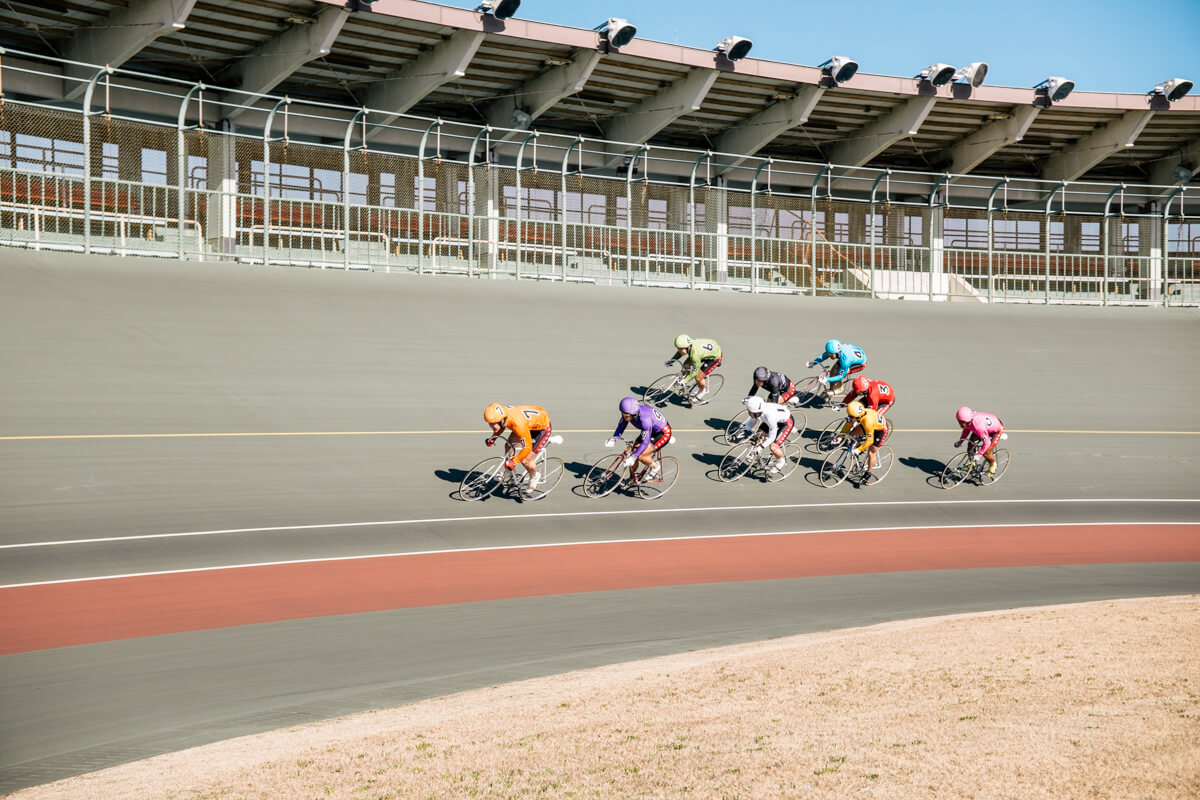

Different racing strategies are employed; some use the steepness of the banked curves to gain speed, others draft behind other cyclists, and some prefer to stay in the lead to avoid having to jockey for position. Number 6 won this particular race.
Why hasn’t Keirin caught on in the States or other parts of the world?
You might be able to catch Keirin races elsewhere, but I think it’s pretty much a Japanese thing. The history is kind of interesting: it started as a state-run way to finance reconstruction following WWII, caught on like wildfire, and now there are dozens of tracks all over Japan. It’s pretty much for gamblers only, and I got the sense that because of that, folks there aren’t keen on promoting it to outsiders. The experience feels more like going to a greyhound track, not watching the Tour de France (or so I’d imagine). It’s a lot of gamblers not watching the races and just placing bets based on numbers. There are more people staring at results on TV monitors than there are in the stands. As for why it hasn’t caught on elsewhere, I don’t know… maybe we’d rather bet on horses and watch the Red Hook Crit, not combine the two. The bikes themselves have found their way all over the place, though, and are highly coveted. They’re beautiful fixed gear bikes. I hear there are going to be quite a few amazing ones at the show on Thursday.
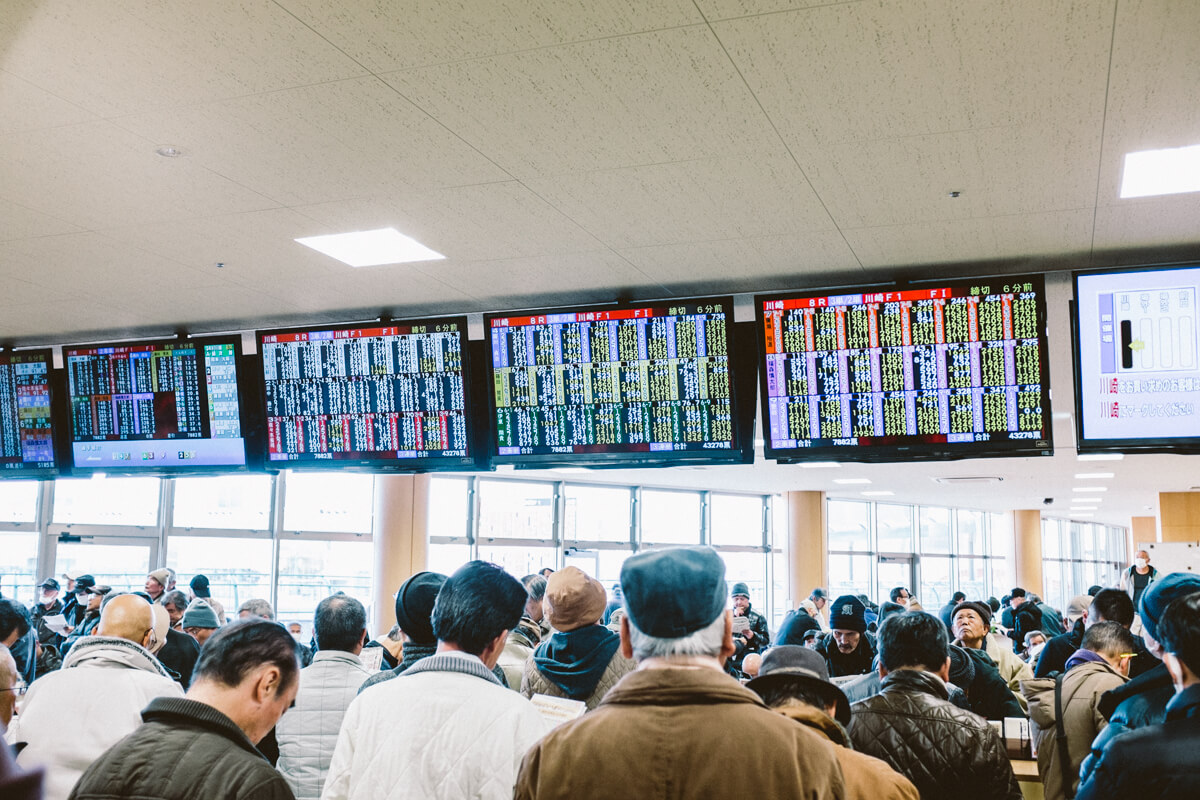

More bettors can be found inside the velodrome watching videos screens than watching the live races themselves
What was the process of taking these photos like?
The only races being held at that time near Tokyo were in a city called Kawasaki, and my friends were able to bring me behind the scenes. I didn’t have much gear with me, but I was able to shoot plenty in the areas where all the cyclists hang out in between races, and I snuck some shots in the betting areas (even though I was asked not to). During the races themselves, I was escorted to the infield of the track and was told that once the races started, I couldn’t move around. I got some nice stuff there, but it all sorta looked the same. I enjoy shooting editorial/reportage stuff more than sports anyway, so I was ok with more of the behind-the-scenes stuff. I didn’t really have a plan for the photos. I posted them on my blog, Preferred Mode, and Benjamin Peck, Harry Schwartzman, and Dave Perry of Bike Cult Show asked if I’d like to collaborate on a Keirin-themed exhibition in a space they had found above Bicycle Habitat in Chelsea. I also hope to make the photos a part of a larger project, but we’ll see what happens.
What’s behind your obsession with bicycles?
I don’t know if I’m obsessed with them, but I definitely like them for a lot of reasons. There are so few things out there that can simultaneously have a positive influence on the health and wellbeing of individuals, societies, economies, and the environment—while being fun as hell. The only downside are the people who aren’t into it and keep it from being as safe as it should be, just so that they can clog city streets with metal, fumes, and noise as conveniently as possible. It baffles me, to put it mildly, that more people don’t recognize bicycles as being one of the closest things we have to a panacea. If you had a cold and someone was like, hey, you have to drink this medicine, sorry, it takes like the BEST SHIT EVER, wouldn’t you just drink it? It’s like, goddamn. And the funny thing is, to mix metaphors, it’s a car that sells itself—you just have to get people to take a spin, and as long as they can feel safe, chances are decent that they’ll buy it. I guess I like that I can contribute to the cause, both by photographing it in interesting ways for my blog, Preferred Mode, and by helping Bike New York teach New Yorkers how to ride. If that makes me obsessed, so be it.
You might also like 










